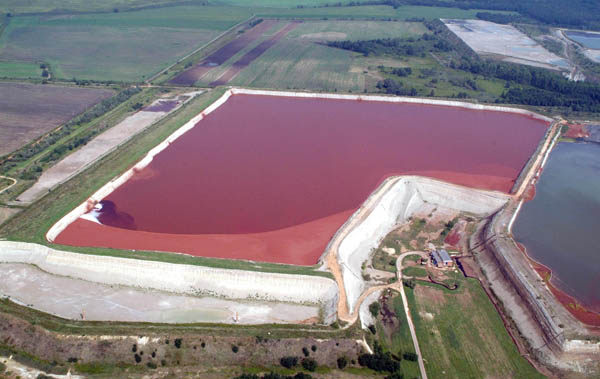Red mud recycling – the challenge of industrial waste circular economy

Red mud – industrial waste circular economy challenge. As a large-scale industry in the aluminum industry, the safe disposal and economic management of its bulk industrial waste red mud is a long-standing challenge. From an economic point of view, the current disposal and management of this bulk waste is far from ideal, facing huge disposal costs and presenting a phenomenon of long-term liabilities. From an environmental point of view, red mud is corrosive, producing large amounts of land and managing it, but producing nothing. Therefore, sustainable red mud waste management should be an increasingly important priority. Dry-stacked red mud can also provide opportunities and advantages for a red mud circular economy.
Red mud composition and thermodynamics. In order to recover metals/materials from red mud and to recycle it, it is crucial to understand the chemical and mineralogical composition of red mud. Therefore, this section reviews and discusses its chemical composition, mineralogical composition, and its thermodynamics. The typical composition of red mud varies from country to country and even from industry to industry due to ore and process differences. The representative composition of red mud mainly contains three oxides, namely (i) major metal oxides such as Fe2O3, Al2O3, TiO2 and CaO, (ii) minor but valuable metal oxides such as V2O5, SiO2 and Ga2O3 , and (iii) rare metal oxides such as rare earth oxides. Red mud can be recycled through valuable metal recovery. In order to recover valuable metals by techniques such as pyrometallurgy or hydrometallurgy, or a combination of the two, both thermochemical and solution chemistry feasibility perspectives need to be focused and fully understood. The thermodynamics of possible valuable metal recovery by pyrometallurgy and hydrometallurgy can be understood by the Ellingham and Pourbaix diagrams.
Red mud resources are realized through beneficiation process. Ore processing techniques can be used to enrich valuable constituents or remove unwanted constituents for efficient resourcing of red mud prior to subsequent pyro and hydrometallurgical processing. The ore beneficiation process as a physical separation has potentially significant economic, environmental and metallurgical benefits. The advantages of ore processing technology are (i) the reduction of valuable metal resources, the waste is landfilled on site, (ii) the burden of subsequent heat treatment or chemical treatment is greatly reduced by eliminating unnecessary materials, (ii) transportation cost savings and (iv) All this makes it carbon-beneficial and eco-efficient.
Pyrometallurgy recovers valuable metals. Pyrometallurgy is the process of heat-treating ores, concentrates or wastes to physically and chemically transform the target metal and realize its recovery. It is mainly suitable for the recovery of iron, lead, zinc, copper, tin and tungsten. Since red mud is a very complex waste, the content of its main components Fe2O3 and Al2O3 is between 20~25% and 10~22%, respectively, and the production is very large. Depending on efficiency and sustainability, pyrometallurgical processes are likely to be the primary processes for red mud recycling through the recovery of iron and aluminum.
Continuous Recovery of Valuable Metals from Red Mud – Prospect. The processes discussed above focus primarily on selective metal recovery rather than total valuable metal recovery. Although there have been few reports on the recovery of valuable metals from red mud, the continuous recovery of most valuable metals has hardly been reported. Cost-effective, low-energy, and green recycling processes are current and future needs, and such processes should be developed to address the challenges associated with recovering valuable metals from wastes such as red mud. Based on the above discussion, this paper proposes a technically-economically favorable and environmentally friendly conceptual process for continuous metal recovery, as shown in Figure 3. The flow chart shows the prospect of recovering valuable metals only from red mud, and also shows several routes for recovering various metals.
Red mud circular economy through valuable metal recovery – an opportunity. Considering the amount of 4 billion tons of red mud stored globally and the metal content in red mud, the total reasonable wealth locked in red mud can be analyzed. It is estimated that the recovery of rare earth metals from red mud could unlock about $4.3 trillion in economic value. Therefore, from a circular economy perspective, the quantitative reclamation of red mud on an industrial scale is of great significance, unlocking a multi-billion dollar opportunity from global red mud inventories.
Alternative red mud recycling – building materials and ceramics. The use of red mud to produce building materials such as cement, glass ceramics, bricks, geopolymers and roofing tiles helps reduce the carbon footprint of the cement production industry and minimizes issues related to its disposal. Since smart cities are the order of the times, red mud can be conveniently used as a building material for urbanization and industrial construction, while addressing environmental, energy and carbon footprint issues. At present, a few literatures have reported the utilization of red mud resources through building materials and ceramics.
Red mud storage appears to be counterproductive due to major concerns about the environment, land scarcity and disposal costs, the current demand for rare earth and valuable metals in industrial economies, and China’s monopoly on the rare earth metal market. The continued practice of storing red mud may also pose management challenges. For countries that rely on metal or ore imports to produce large amounts of aluminum, red mud is often a suitable secondary resource for rare earth metals, especially scandium. Recovery of valuable metals, such as rare earth metals, from red mud is a viable option to meet the demand for such metals. Although the literature has included some patents and academic papers, the optimal utilization of red mud on an industrial scale is almost non-existent. Valuable metal recovery of large quantities of underutilized red mud requires more attention.
